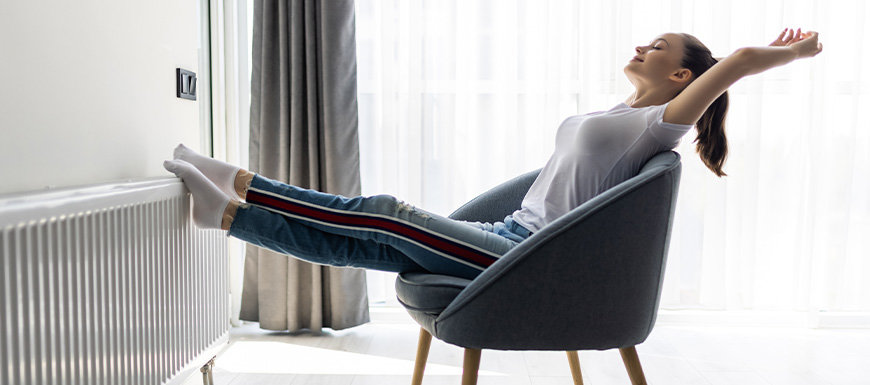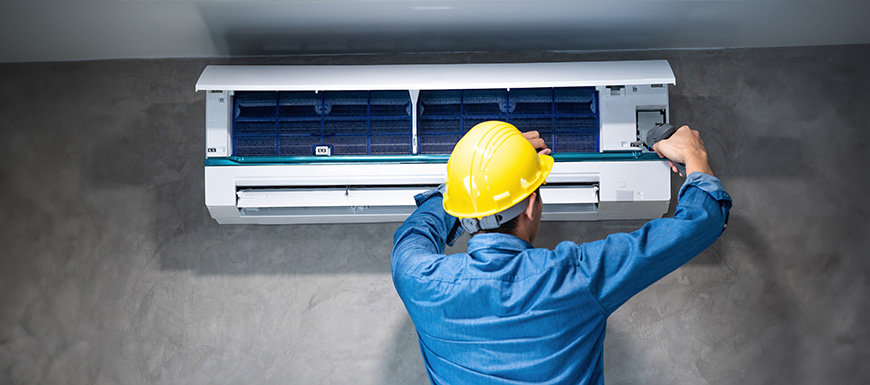
Say what now? You may never have heard of air balancing, but chances are you’ve experienced the imbalance at some point. Ever noticed hot and cold spots in your home? And no matter how much you adjust the thermostat you can just never seem to get it right? This is a sign that your HVAC system is out of whack.
If your system is not distributing the heating and cooling evenly throughout your home or building it means you need air balancing.
What is Air Balancing?
Our HVAC system is made of up multiple elements like the furnace, AC system, ductwork, vents, and dampers. If they are not working in concert, the system will be out of balance. Air balancing works to ensure even airflow through the heating, cooling, and ventilation to produce the right temperature, humidity, and air quality ideal for your location.
When an HVAC system is new, installers calibrate everything to produce optimal building performance. But as time passes different things can impact the system and the airflow. This can happen if:
The dampers or vents have been changed.
You’ve changed the layout with a new addition.
Blocked airflow from adding or removing walls.
Damaged insulation or ductwork.
Reduced air coming from the outside due to updated windows and doors, changing the airflow needs.
"Balance is key. Balance is everything."
- Mr. Miyagi (Karate Kid)
So, what are the key signs that your building is experiencing an imbalance? Take note if:
Persistent hot or cold spots are in the same rooms. Caused by blocked air ducts or uneven airflow distribution.
Rising energy bills.
Vents that just don’t seem to work even with the vent damper completely open.
Vents that make a whistling sound when partially closed because they get too much airflow.
A temperature difference of more than two degrees between floors.
Too much dust, humidity, or airborne contaminants.
Musty or stale air in specific parts of the location.

Why is Air Balancing important?
HVAC systems work hard to evenly distribute conditioned air, whether hot or cold, to the entire residential building; larger more robust systems do the same for commercial buildings. A well-balanced system will:
Maintain optimal performance.
Proper air balancing means all the parts of your HVAC system are working together in harmony which ensures maximum efficiency, reducing energy costs. When the temperature isn’t quite right in one area, people tend to crank the heat or AC to try and fix it, wasting energy and increasing your bills.
"If whole life have balance. Everything be better. Understand?"
- Mr. Miyagi
Better Air quality
When your system is running at its best it will be better at removing excess humidity and air pollution from your home. Optimal airflow helps prevent air contaminants like pollen and mold spores from spreading. It also helps stop rooms from feeling stale and stuffy by properly injecting all spaces with fresh air.
Greater comfort
The more balanced the airflow the more evenly distributed the temperature is across the building. It means consistent, reliable comfort no matter what room or floor. In your home, you’ll hear less complaints from the kid who has the hot room. At the office, employees will no longer have to bring that sweater, and the more comfortable people are the more productive they will be at work. Or at least one can dream.
Hiring a professional can help.
“Not everything is as looks, you know.”
- Mr. Miyagi
A technician can assess and help create air balancing. Professionals will measure the amount of air flowing through each part of your HVAC system – including the ductwork and vents. They will use anemometers, manometers, and smoke generators to perform diagnostic tests to determine where the issues lie and employ the necessary air balancing techniques and adjustments.
Air balancing hoods placed over the vents will measure the amount of air passing through. Manometers measure the air pressure and help locate blockages. A professional will also look at the unit’s fan speed, dampers, and even ductwork size. You may not realize but larger rooms will more than likely require more air volume. This could result in installing a larger vent and ductwork. Rooms that sit at the end of a duct line might need more air pressure, requiring smaller ductwork. Their solutions could include damper adjustments or installing dampers where none currently exist, changing the fan speed, replacing lines, or in some cases suggesting a change in the HVAC unit itself.
The findings from all these tests will compile a report, to help you understand the problems and the solutions. Some common issues are:
Damaged ducts causing air leakage.
Loose duct joints.
Collapsed flex ducts.
Design flaws in the ventilation system, common in multi-story buildings. Some examples include undersized ducts, duct runs that are too long or that have too many sharp turns.
Blocked ducts, often from old insulation or an object like and old air filter.

What does a pro cost?
On average a technician will charge $75-100 per opening. This can add up fast. A typical family home would cost $750- $2,000 depending on the number of vents and the design and accessibility of the HVAC system.
What you can do on your own
“Remember, best block no be there.”
- Mr. Miyagi
It’s recommended to call a technician in for their access to diagnostic tools and ability to fix identified issues, but you can still check off a few things on your own.
Here are 16 things you can DIY:
Check for air leaks. Seal any openings and cracks to prevent air from escaping.
Change your air filters regularly and according to the manufacturer's instructions. Clogged filters can reduce airflow.
Inspect your ducts and vents. Blockages will reduce efficiency.
Look at where your vents and furniture are located. If any vents are blocked rearrange.
Get your air ducts cleaned.
Adjust the temperature settings to accommodate the cold or hot spot, being mindful that without addressing the root cause you will increase your energy use.
Adjust the vent covers according to the season. In the summer keep all vents open on the top floor and closed on the bottom to allow more cool air where its hottest. In the winter close the vents on the top floor and open the vents on the bottom floor as warm air will rise.
Conduct a temperature test. Set your home to 23 degrees Celsius for 24 hours then check the temperature of each room in the house and compare it to the thermostat settings.
Conduct an air pressure test. Turn on the fan and check each vent from room to room. Establish a scale of high, medium, or low based on feel, striving for medium at each register. You can also place a piece of paper over the vent. Hold the top edge and let the bottom of the paper float. Look at how far the paper blows from the wall. You can then get a good gauge of airflow.
Set your thermostat fan to “on” so your furnace blower is constantly pushing air throughout the house.
Never put electronic equipment near your thermostat. Electronics put off heat and if your thermostat picks this up it will not guide your HVAC system accurately, and in the summer will cause your AC to operate longer.
Consider getting a magnetic air deflector to help redirect air coming from your ventilation system.
Add window coverings and use them! 76% of sunlight coming into your house gets converted to heat. While welcome in the winter, you may not want additional heat on sweltering summer days. Know that your windows will have influence on the temperature of each room and can impact your air balancing.
Use your ceiling fans to improve air circulation and energy efficiency. In warmer months ceiling fans should go counterclockwise to create a cool downward airflow. In the winter, fans should turn clockwise to distribute heat throughout the building.
If you live in a region that has big seasonal temperature swings you might consistently adjust your dampers at the start of summer and winter. Homeowners can make it easy on themselves by writing summer and winter on the right side of the duct so it’s ready for the next time.
Make sure the size of your HVAC system is the right size for your home. A unit too small will work harder using more energy. A unit too large will over condition, running short cycles and operate inefficiently. Neither will result in the best home comfort.

Find the balance.
“The answer is only important if you ask the right question.”
- Mr. Miyagi
Air balancing is a crucial step to keep your HVAC system running efficiently. It will lower energy costs and maintain comfort with temperature consistency throughout your home. Proper air circulation also improves air quality, reducing stale air and indoor air pollution.
Try and make your own adjustments but recognize a professional technician will identify and fix many of the common issues for you.
